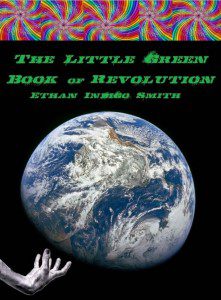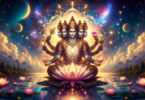Contributing writer for Wake Up World
Ascension is like shedding the cocoon of unconscious ignorance.
The meaning of ascension differs from person to person. For some it may simply be breaking patterns causing unhappiness, for others ascension may be heightening their intuition or healing power.
Ascension for the collective consciousness will be breaking patterns that cause unhappiness and healing from the destruction and pollution caused by global war and global pollution of the coinciding petrolithic and nuclear eras. Ascension is not magical or ethereal, although it can be, it begins with self-realization and maturing.
The Zohar is a Kabalistic text. It first appeared publicly in the 13th century. In it there is a formula in the formation of the matrix of four used for theological interpretation. Legend has it this formation of four is a final step on the path to ascension and understanding. The formula is known as the four PaRDeS, the capitalized letters represent the four aspects translated from Hebrew, in such translations vowels are ignored. Conveniently the combination of PRDS is similar to paradise, where ascension through consideration of the four aspects supposedly can lead.
Legend has it that the four PaRDeS, as a final step to ascension, can be dangerous. They are enlightening to the extent that someone un-ready for enlightenment might be harmed in the same way a vessel un-ready for intense heat might be cracked. The most meaningful sets of four frequently contain this powerful attribute; enlightenment can shake, rattle and roll consciousness. I can verify the enlightening factors in the four PaRDeS and can verify the potential danger in any enlightenment, for most people do not like change, even if it is ascension through enlightenment, even if their refusal to change pains them and holds them down.
The four PaRDeS from the Kabalistic text The Zohar are of Jewish origin, but they are valuable beyond Judaism and beyond religious interpretation. I do not endorse any religion which inspires individuals and collectives to enact any “us and them” ideas or policies. The monotheism of Judaism, Christianity and Islam all worship different faces of the same god. The most obvious example of this potentiality, aside from their shared mythology, is their shared organizational detriment. Their great flaw is that each considers itself as the sole possessor of the sole key to unlock spiritual ascension. In fact there are many ways to reach spiritual ascension.
In fact the best way to ascend is within you, not in institution of any model.
The four PaRDeS, the four ways to understand and interpret theology are the literal, the allegorical, the comparative and the secretive. The first two are obvious, the comparative and secretive are more subtle and normally left unconsidered possibly because of the difficulty in deciphering. Awareness of the four forms of interpretation is valuable in understanding theological presentation as well as in understanding society.
The Four PaRDeS of theology extrapolated as a lens to view society is layered firstly by surface understanding, our individual senses.
The secondary more elaborate layer of understanding society arrives in the teachings of others. Thirdly is a combination of collective learning and our own experience used comparatively. Lastly is the intuitive approach where one cannot explain exactly how one reaches an answer, but the answer is correct. All theology or theosophy points the intuitive power inside individuals and all of processes to reach that point.
The matrix of four PaRDeS leads to enlightenment of theological unknowns. And as translated or transmuted into a window from which one can view societal unknowns, it is an equally valuable four-fold formula. What were shadows are opened up to light. Carl Jung elaborated a similar transformation of consciousness or ascension through another powerful, nearly as divine formation of four, this one psychological.
Carl Jung’s formation of ways to deal with unknowns is concerned with the unknown aspects of consciousness. He termed these unknowns as the Shadow. One can act in denial, projection, integration, or transmutation of the unknown shadow of self-consciousness and the collective consciousness. In the process of ascension there is always a point in which tumult and turmoil of facing our individual and collective shadows is too much resulting in people turning back down or staying still, but transcending it, transmutation results in a newness beyond the said tumult.
The Four PaRDeS are based on the principle that all visible phenomena have exoteric reality and an esoteric reality. Carl Jung’s formation of four ways to deal with the shadow is based on the same idea and addresses the same process of addressing unknowns and each describes ascension. First we understand only the exterior, then the interior, then we form our own integration and the ultimate and most developed fourth part is transmutation, or ascension. Transmutation can only be processed in love or loving compassion. Loving compassion is central in all theological concepts, yet so often is absent from religious constructs.
Love is a four-fold concept and ascension process in itself as well, as theorized by Buddha. The first aspect of love is the love of self and one has to take this step before being able to ascend into higher levels of love. Second is the love of others, third is the love of the happiness of others and fourth is the love of all things in equanimity.
Each of these four formations, the four PaRDeS of theology, the four PaRDeS of society, the four ways to deal with the shadow of consciousness and the four aspects of love can be combined together to help individuals reach ascension. And also the formations can enhance and enable the power of a conscious individual to positively affect the collective.
The Little Green Book of Revolution
By Ethan Indigo Smith…
 The Little Green Book of Revolution is an inspirational book based on ideas of peaceful revolution, historical activism and caring for the Earth like Native Americans.
The Little Green Book of Revolution is an inspirational book based on ideas of peaceful revolution, historical activism and caring for the Earth like Native Americans.
A pro-individual and anti-institutional look at the history of peaceful proactive revolution, it explores the environmental destruction inherent to our present political and energy distribution systems, and offers valuable and insightful ideas to counteract the oligarchical institutions of the failing ‘New World Order’.
The Little Green Book of Revolution is available here on Amazon.
About the author:
 Activist, author and Tai Chi teacher Ethan Indigo Smith was born on a farm in Maine and lived in Manhattan for a number of years before migrating west to Mendocino, California. Guided by a keen sense of integrity and humanity, Ethan’s work is both deeply connected and extremely insightful, blending philosophy, politics, activism, spirituality, meditation and a unique sense of humour.
Activist, author and Tai Chi teacher Ethan Indigo Smith was born on a farm in Maine and lived in Manhattan for a number of years before migrating west to Mendocino, California. Guided by a keen sense of integrity and humanity, Ethan’s work is both deeply connected and extremely insightful, blending philosophy, politics, activism, spirituality, meditation and a unique sense of humour.
Ethan’s publications include:
- 108 Steps to Be in The Zone, a set of 108 meditative practices for self discovery and individual betterment, including techniques to develop balance, transmute sexual energy.
- The Matrix of Four, The Philosophy of the Duality of Polarity on the subject of the development of individual consciousness.
- The Little Green Book of Revolution an inspirational book based on ideas of peaceful revolution, historical activism and caring for the Earth like Native Americans.
- The Geometry of Energy: How to Meditate: Simple and profound, this book offers an empowering four-step meditation, focused through the sacred dimensions of geometry.
- The Complete Patriot’s Guide to Oligarchical Collectivism, an insightful exploration of history, philosophy and contemporary politics.
- The controversial book, Terra-ist Letters, a work that humorously contrasts two very serious issues: the prohibition of marijuana and the promotion of nuclear experimentation.
For more, visit Ethan on Facebook and check out Ethan’s author page on Amazon.
Recommended reading by Ethan Indigo Smith:
- The Mandala: The Sacred Geometry of Meditation
- Mutually Agreed Peace: Ending The Doctrine of Perpetual War
- Why “Alternative” Media is the New Mainstream
- Tibetan Rites of Rejuvenation: a Guide to Meditation and Breath
- The Netherworld Oligarchy – Who is Your Government Really Serving?
- Understanding Ascension: The Geometry of Energy
- The Big “If” – What If Marijuana and Hemp Had Never Been Prohibited?
- A Little Green Revolution: the Rainbow Warriors will Heal the Earth Mother
- The Dangers of Institutional Thinking – Lessons from 1984, The Matrix, and The Allegory of The Cave
- Why Governments Promote Deadly Nuclear Energy and Ban Beneficial Hemp
- Hate: The Ultimate Social Control Mechanism
- Oligarchy and the War on Individualism

If you've ever found value in our articles, we'd greatly appreciate your support by purchasing Mindful Meditation Techniques for Kids - A Practical Guide for Adults to Empower Kids with the Gift of Inner Peace and Resilience for Life.
In the spirit of mindfulness, we encourage you to choose the paperback version. Delve into its pages away from screen glare and notifications, allowing yourself to fully immerse in the transformative practices within. The physical book enriches the learning process and serves as a tangible commitment to mindfulness, easily shared among family and friends.
Over the past few years, Wake Up World has faced significant online censorship, impacting our financial ability to stay online. Instead of soliciting donations, we're exploring win-win solutions with our readers to remain financially viable. Moving into book publishing, we hope to secure ongoing funds to continue our mission. With over 8,500 articles published in the past 13 years, we are committed to keeping our content free and accessible to everyone, without resorting to a paywall.







